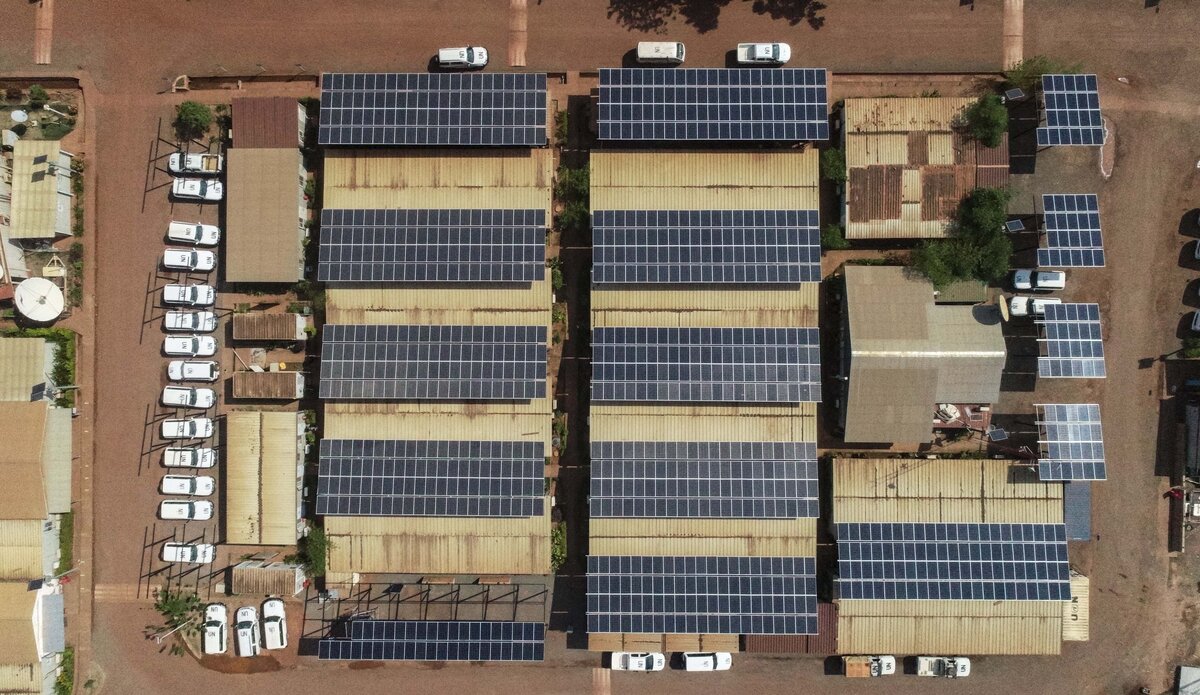Trimming MINUSCA’s carbon footprint through solar energy
Bangui’s tropical weather is arguably one of its greatest assets – as a source of renewable energy. With average annual temperatures in the Central African Republic’s capital soaring to 29 degrees Celsius, the city’s scorching heat is providing a reliable, more affordable source of energy for the UN peacekeeping mission in the country.
A solar energy project launched by the MINUSCA Engineering Section earlier this year will soon be lighting up MINUSCA’s vast premises – with the size, power-consumption needs and south-facing layout of some of the Mission’s largest bases favouring its ambition to harness solar power.
New solar-diesel hybrid electric system
MINUSCA exclusively relies on diesel generators for its energy needs at present. Reducing the Mission’s carbon footprint and dependency on fossil fuels is key,
according to Electrical/Mechanical Unit Supervisor Gerard Wade.
Installation of a 300kW solar-diesel hybrid electric system at the MINUSCA Logistics Base started in January. Over the course of several months, a team of technicians put up steel frames and a cabling system for 1,200 solar panels. Work to put in place inverters as well as a power-conversion control mechanism to synchronize solar power with the generators is ongoing.
The renewable energy project is expected to cut MINUSCA’s dependency on generator use and fuel consumption by 35 to 40 percent – the equivalent of about USD 168,000 in annual savings on fuel.
Reducing generator usage will prolong the life of generators by eight to twelve years and cut back on maintenance schedules – this will further increase savings on oil, spare parts and labour,
noted Gerard Wade.

Lighter carbon footprint
Crucially, embracing solar power will translate into a notable reduction in the Mission’s carbon footprint, amounting to over 360,000 kilograms of carbon dioxide emissions annually – equivalent to 360 gasoline cars being used for six months, with a mileage of 10,000 kilometers each. Moreover, power consumption in office spaces is expected to decrease as the solar panels provide a shade and help cool exterior surfaces.
The solar project is aligned with the Environment Strategy of the United Nations Department of Field Support, developed in collaboration with missions and other partners to implement its vision for “responsible missions that achieve maximum efficiency in their use of natural resources and operate at minimum risk to people, societies and ecosystems.”
MINUSCA will, in line with the strategy, continue to implement other measures to reduce its overall environmental footprint. The Mission is, for instance, in the process of replacing fluorescent lighting with energy-efficient LED lighting alternatives.
Solar panel installation at MINUSCA’s Logistics Base will be completed in June this year. The second phase of the project at the Mission’s other premises is set to run from April to September 2021 – and is expected to result in similar savings and reductions in carbon dioxide emissions.
Importantly, the in-house nature of the operation is also strengthening local expertise – with national technicians gaining knowledge of solar power systems and valuable work experience.

Lighting up MINUSCA’s field locations
Plans are in the pipeline to extend the renewable energy roll-out to other locations across the Central African Republic, with Birao, Berbérati and Obo next in line; sector headquarters in Kaga-Bandoro, Bouar and Bria are also under consideration.
The solar energy project is set to be completed in 2023 – with a full return on investment expected within the next two years.
 UN
UN United Nations Peacekeeping
United Nations Peacekeeping





